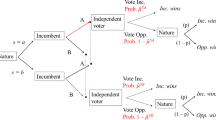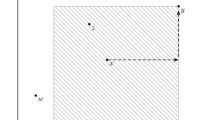Abstract
This paper distinguishes between electoral platforms and implemented policies through a non-trivial policy-setting process. Voters are sophisticated and may care not only about the implemented policy but also about the platform they support with their vote. We find that while parties tend to polarize their positions, the risk of alienating their constituency prevents them from radicalizing. The analysis evidences that the distribution of the electorate, and not only the (expected) location of a pivotal voter, matters in determining policies. Our results are consistent with the observation of polarized platforms and moderate policies, and the alienation and indifference components of abstention.
Similar content being viewed by others
References
Alesina A, Rosenthal H (1995) Partisan politics, divided government, and the economy. Cambridge University Press, Cambridge
Alesina A, Rosenthal H (1996) A theory of divided government. Econometrica 64(6):1311–1341
Alesina A, Rosenthal H (2000) Polarized platforms and moderate policies with checks and balances. J Public Econ 75:1–20
Ansolabehere S, Snyder JM Jr (2000) Valence politics and equilibrium in spatial election models. Public Choice 103:327–336
Aragonés E, Palfrey T (2002) Mixed equilibrium in a downsian model with a favored candidate. J Econ Theory 103(1):131–161
Austen-Smith D (1989) Sincere voting in models of legislative elections. Soc Choice Welf 6(4):287–299
Austen-Smith D, Banks J (1998) Elections, coalitions and legislative outcomes. Am Polit Sci Rev 82:405–422
Bernhardt MD, Ingberman DE (1985) Candidate reputations and the ‘incumbency effect’. J Public Econ 27:46–67
Budge I, Hofferbert RI (1990) Mandates and policy outputs: U.S. party platforms and federal expenditure. Am Polit Sci Rev 84(1):111–131
Budge I, Hofferbert RI (1992) The party mandate and the Westminster model: election programmes and government spending in Britain. Br J Polit Sci 22:151–182
Calvert RL (1985) Robustness of the multidimensional voting model: Candidate motivations, uncertainty, and convergence. Am J Polit Sci 29:69–95
De Sinopoli F Iannantuoni G (2003) A spatial voting model where proportional rule leads to two-party equilibria. CEIS Tor Vergata – Research Paper Series No. 31
Dixit A, Grossman GM, Gul F (2000) A theory of political compromise. J Polit Econ 108(3):531–568
Ellman M, Wantchekon L (2000) Electoral competition under the threat of political unrest. Quart J Econ 115(2):499–531
Fiorina M (1974) Representatives, roll calls, and constituences. D. C. Heath, Lexington, MA
Fudenberg D, Tirole J (1991) Game theory. MIT Press, Cambridge
Gerber A, Ortuño-Ortín I (1998) Political compromise and endogenous formation of coalitions. Soc Choice Welf 13(3):445–454
Green D, Schickler E, Palmquist B (2002) Partisan hearts and minds: political parties and the social identities of voters. Yale University Press, New Haven
Grossman GM, Helpman E (1996) Electoral competition and special interest politics. Rev Econ Stud 63(2):265–286
Hofferbert RI, Klingemann H-D (1990) The policy impact of party programs and government declarations in the Federal Republic of Germany. Eur J Polit Res 18:277–304
King G, Laver M, Hofferbert RI, Budge I, McDonald MD (1993) Party platforms, mandates, and government spending. Am Polit Sci Rev 87(3):744–750
Klingermann H-D, Hofferbert RI, Budge I, Keman H, Pétry F, Bergman T, Strom K (1994) Parties, policies and democracy. Westview Press, Boulder
Kollman K, Miller JH, Page SE (1992) Adaptive parties in spatial elections. Am Polit Sci Rev 86(4):929–937
Lizzeri A, Persico N (2001) The provision of public goods under alternative electoral incentives. Am Econ Rev 91(1):225–239
Llavador HG (2000) Abstention and political competition. Rev Econ Des 5(4):411–432
Londregan J, Romer T (1993) Polarization, incumbency, and the personal vote. In: Barnett WA, Hinich MJ, Schofield NJ (eds) Political economy: institutions, competition, and representation, chapter 14. Cambridge University Press, Cambridge, pp 355–377
McCarty N, Poole KT, Rosenthal H (2003) Political polarization and income inequality. Russell Sage Foundation Working Paper # 201
Ortuño-Ortín I (1997) A spatial model of political competition and proportional representation. Soc Choice Welf 14:427–438
Persson T, Tabellini G (2000) Political economics. Explaining economic policy. The MIT Press, Cambridge
Poole KT, Daniels S (1985) Ideology, party, and voting in the U.S. congress, 1959–80. Am Polit Sci Rev 79:373–399
Poole KT, Rosenthal H (1984a) The polarization of American politics. J Polit 46:1061–1079
Poole KT, Rosenthal, H (1984b) U.S. presidential elections 1968–1980: A spatial analysis. Am J Polit Sci 28:283–312
Poole KT, Rosenthal H (1991) Patterns of congressional voting. Am J Polit Sci 35:228–278
Poole KT, Rosenthal H (1997) Congress: A political-economic history of roll call voting. Oxford University Press, New York and Oxford
Rabinowitz G. Macdonald SE (1989) A directional theory of issue voting. Amer Polit Sci Rev 83(1):93–121
Roemer JE (1997) Political-economic equilibrium when parties represent constituents: The unidimensional case. Soc Choice Welf 14:479–502
Roemer JE (2001) Political competition: theory and applications. Harvard University Press, Cambridge
Snyder JM Jr (1994) Safe seats, marginal seats, and party platforms: The logic of platform differentiation. Econ Polit 6:201–213
Snyder JM Jr (1996) Constituency preferences: California ballot propositions, 1974–1990. Legis Stud Quat 21:463–488
Wittman D (1977) Candidates with policy preferences: A dynamic model. J Econ Theory 14:180–189
Author information
Authors and Affiliations
Corresponding author
Rights and permissions
About this article
Cite this article
Llavador, H. Electoral Platforms, Implemented Policies, and Abstention. Soc Choice Welfare 27, 55–81 (2006). https://doi.org/10.1007/s00355-006-0111-5
Received:
Accepted:
Published:
Issue Date:
DOI: https://doi.org/10.1007/s00355-006-0111-5




